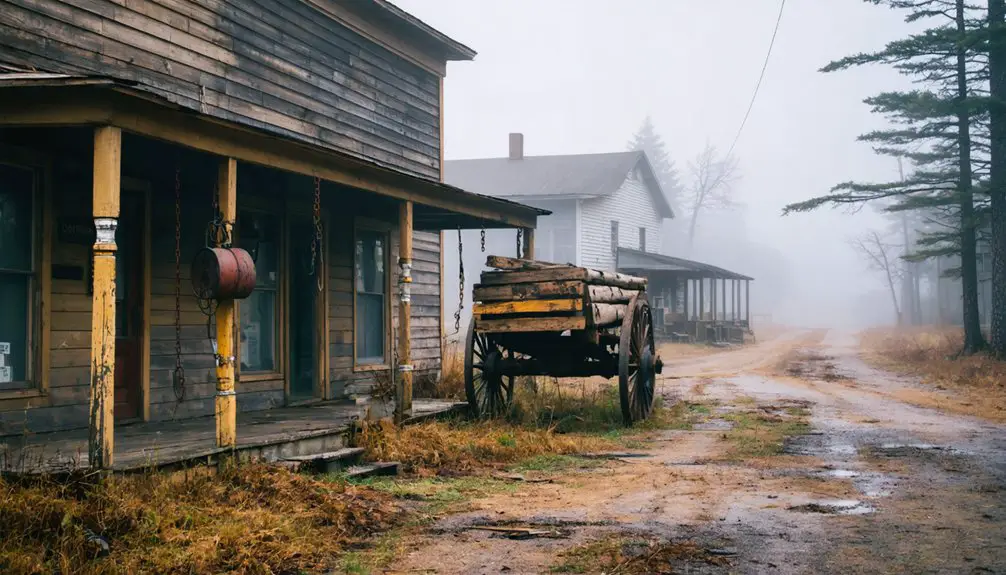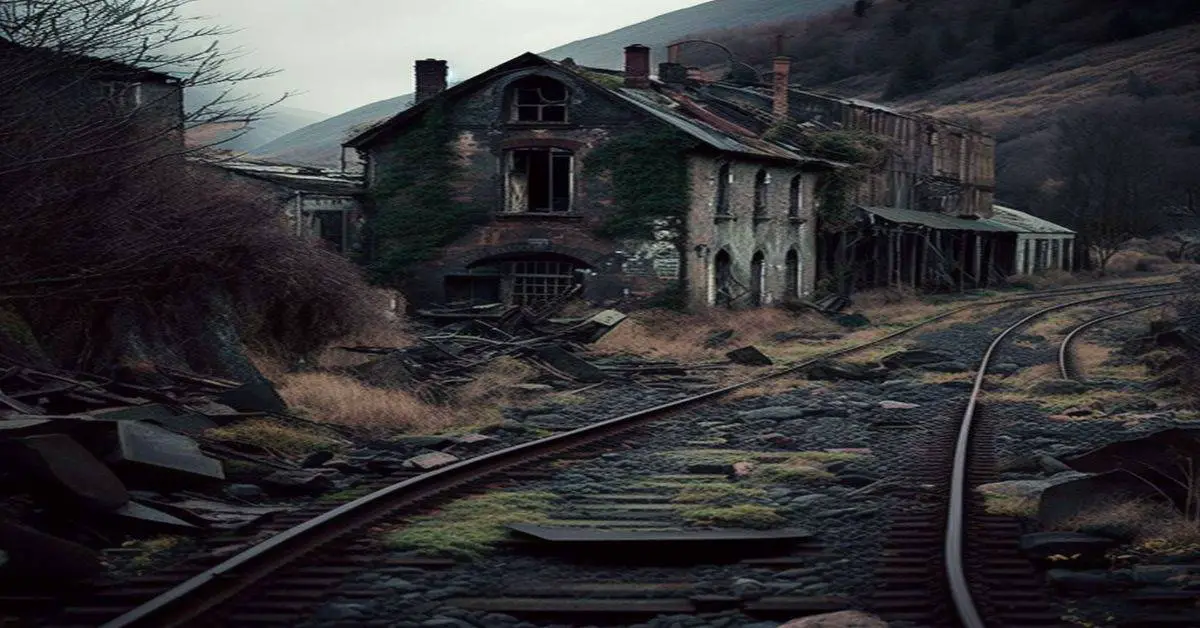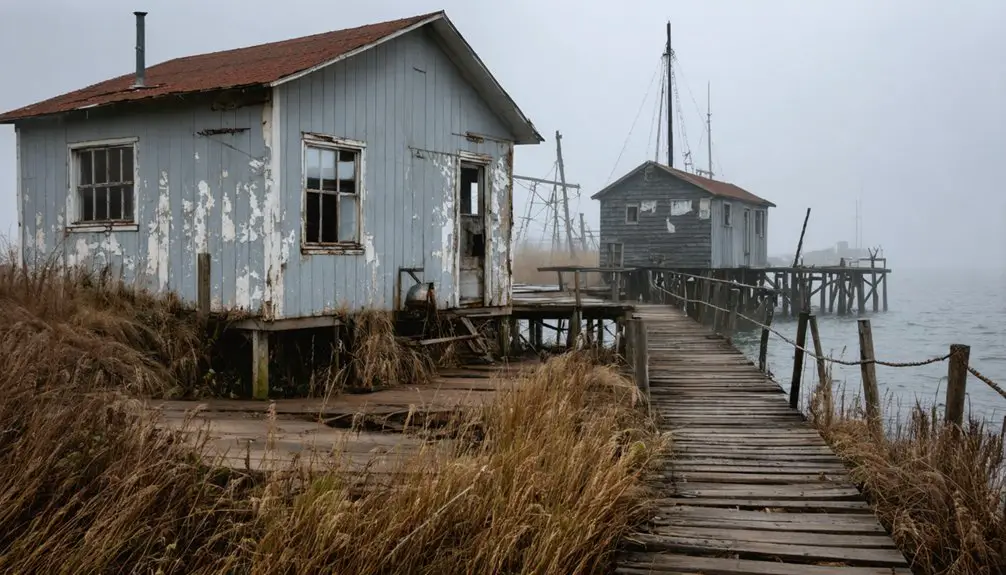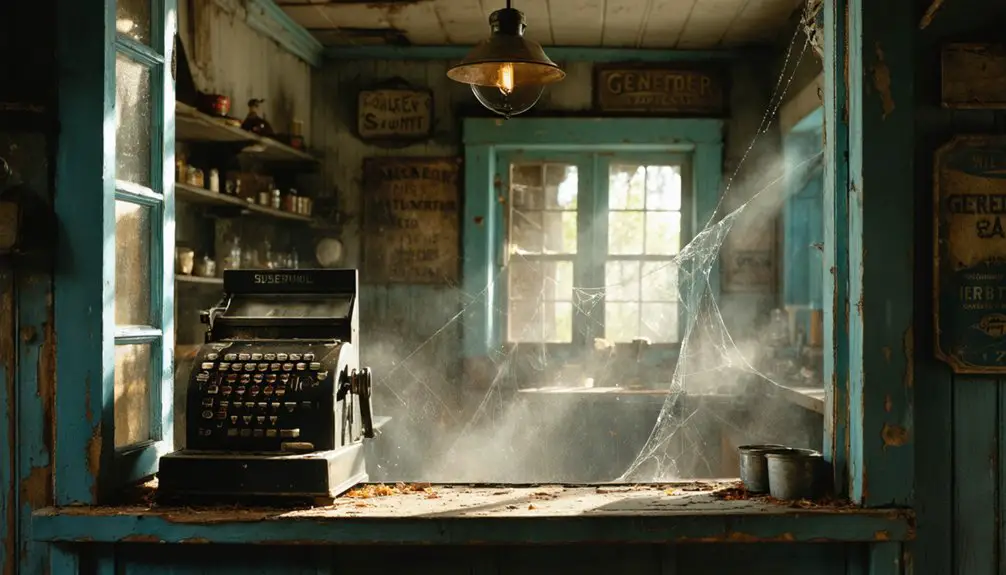You’ll find Kennedy in Wisconsin’s logging history as a company town established in 1908 when Willard Walther of Dells Lumber and Pulp Company purchased and platted the land. The settlement grew to 25 families, with seven logging camps connected by rail spurs to the Omaha Railway. After thriving through the 1920s, Kennedy declined as timber resources dwindled, and by 1939 its school closed. The site’s foundations now fade into the forest, but its story illuminates Wisconsin’s resource boom-and-bust cycles.
Key Takeaways
- Kennedy was established in 1908 as a logging community in Wisconsin, growing to 25 families before becoming a ghost town.
- The town’s economy centered around Dells Lumber and Pulp Company, with seven logging camps connected by railroad spurs.
- A post office, school, general store, and boarding houses served the community during its peak in the 1920s.
- The town declined due to timber depletion and the struggling lumber industry, with the school finally closing in 1939.
- Today, only foundation traces remain at the site, though Kennedy’s history is preserved in local archives and museums.
The Birth of a Logging Settlement
When Cornell University sold its land grant holdings to the Sage Land Company in the early 1900s, it set in motion the birth of Kennedy, Wisconsin.
You’ll find the story begins with Willard Walther of the Dells Lumber and Pulp Company, who purchased the land for $600 and platted the community in 1908.
The settlement’s logging techniques centered on winter operations, when frozen ground made it easier to transport heavy timber.
Seven logging camps connected to Kennedy via spur railroad lines, creating a hub of activity that drew workers and their families. The town name required internal links clarification to distinguish it from other places named Kennedy.
Community dynamics evolved from a basic logging camp into a thriving settlement, complete with a schoolhouse, post office, and essential businesses. The population grew steadily to include twenty-five families by the 1920s.
Railroad’s Role in Kennedy’s Growth
You’ll find Kennedy’s railway network was extensive, with seven spur lines stretching northward to connect logging camps to the main Omaha Railway terminus.
Similar to how grassroots movements influenced railroad development in La Crosse, local residents helped shape Kennedy’s rail expansion through community advocacy.
The railway’s freight operations transformed Kennedy into a bustling hub, enabling the efficient transport of timber products while attracting businesses like general stores, boarding houses, and hotels that served workers and travelers. These businesses thrived as freight rates decreased significantly compared to wagon transport.
As the primary transportation artery through 1916, the railroad established Kennedy’s position as an essential regional transit point, particularly for the Dells Lumber and Pulp Company’s operations.
Railway Spurs Connect Camps
As Kennedy established itself as a logging hub in the early 1900s, the construction of seven strategic railway spurs stretching northward to the Ashland County border transformed the town’s timber operations.
These essential rail connections revolutionized logging logistics by linking isolated camps directly to the Omaha Railway mainline at Kennedy.
You’d find these spurs serving multiple important functions – they weren’t just for hauling timber. The rail lines transported camp supplies, equipment, and workers through challenging terrain that would’ve been nearly impossible to navigate by road.
They enabled camps to load harvested logs efficiently onto trains bound for processing or shipping. Much like the early steam railways documented in historical publications from 1924-1928, this network of spurs proved significant in expanding logging operations deeper into the forests while maintaining quick access to Kennedy’s railway hub.
Freight Operations and Commerce
The expansion of Kennedy’s railway network into a freight operations powerhouse transformed the town’s economic landscape in the early 1900s.
You’ll find that the railway’s freight efficiency revolutionized Kennedy’s commercial potential, making previously unprofitable ventures lucrative through drastically reduced shipping costs. The town’s rail system achieved transportation speeds of 10 to 15 mph, significantly outpacing traditional wagon delivery methods. The railway’s automatic block signaling system enhanced safety and scheduling reliability along major routes.
The impact on local commerce was profound, as evidenced by:
- Seamless freight interchanges with major lines like Milwaukee Road, enabling swift distribution of timber products
- Strict scheduling protocols that guaranteed timely delivery of raw materials and supplies
- Enhanced transportation economy through optimized cargo loads per locomotive
- Support for ancillary businesses through reliable supply chains
This freight infrastructure turned Kennedy into a thriving hub, though its prosperity remained tightly bound to the railroad’s continued service – a dependency that would later seal its fate.
Transportation Hub Development
Railroad tracks laid by the Omaha Railway in 1908 established Kennedy’s destiny as a pivotal transportation hub, marking the town’s initial plat near the railway terminus.
You’ll find that this strategic location transformed Kennedy into a gateway for settlers heading to Rice Lake, while spurring the development of extensive transportation networks throughout the region. Similar to the mixed freight-passenger service that operated on other regional lines, Kennedy’s rail system served multiple transportation needs. The railway’s presence connected Kennedy to major carriers like BNSF Railway which expanded regional access.
The railway’s presence attracted major players like Dells Lumber and Pulp Company, which established offices nearby.
You can trace how settlement patterns evolved around seven significant spur lines that connected Kennedy to surrounding logging camps.
The railroad’s influence extended beyond timber transport – it shaped the town’s growth by facilitating the establishment of schools, taverns, stores, and boarding houses.
Even after the 1916 road construction, the rail remained essential for heavy freight movement.
Life in Early Kennedy
Logging operations shaped Kennedy’s early development after its 1908 platting, with the Dells Lumber and Pulp Company establishing headquarters west of the settlement.
As a bustling logging community, you’d find yourself among workers drawn to the timber-rich region, where early commerce thrived through essential businesses serving both residents and travelers. Much like Henry Kennedy’s tavern in nearby Saratoga, local establishments became important meeting places for the community.
Life in early Kennedy centered around:
- The train station and railway spurs connecting to seven logging camps
- Local gathering spots including taverns, a boarding house, and a hotel
- A general store providing necessary supplies for daily life
- Educational facilities, starting with a log schoolhouse before upgrading to a framed structure
You’d experience a typical early 1900s Wisconsin logging town atmosphere, where hard work and social connections merged at local establishments after long days in the timber industry.
Notable Buildings and Landmarks

Standing prominently among Kennedy’s landmarks, Dells Lumber and Pulp Company‘s headquarters anchored the town’s western edge while serving as its economic nucleus.
You’d find the original log schoolhouse, later replaced by a larger frame structure in 1911, marking the town’s historic significance. Along the Omaha Railway tracks, the train station facilitated both passenger travel and timber transport, while nearby taverns, a boarding house, and a general store formed the town’s commercial heart.
The post office, established in 1911, represented federal recognition of Kennedy’s importance.
Though the architectural features of these buildings varied from utilitarian railway structures to more permanent civic establishments, they collectively showcased Kennedy’s evolution from a logging camp into an organized community of about 25 families.
The Rise and Fall of Timber Operations
When J.J. Kennedy founded the Rib Lake Lumber Company in 1882, he established a timber heritage that would transform Wisconsin’s landscape.
You’ll find the evolution of logging techniques reflected in Kennedy’s rapid industrialization, from horse-drawn sleighs to advanced railroad networks.
The company’s growth paralleled the region’s timber boom, marked by:
- Construction of a crucial railroad spur connecting to Wisconsin Central Rail Road
- Implementation of bull chains and specialized machinery for efficient log handling
- Production exceeding one billion board feet of lumber
- Expansion to seven northern logging camps under Dells Lumber and Pulp Company
Daily Life in a Lumber Town

Life in Kennedy’s lumber camps revolved around a demanding yet structured daily rhythm that shaped the community’s character. You’d find lumberjack camaraderie flourishing in the bunkhouses, where workers gathered after dark to share stories, music, and repair their gear.
Camp routines started before dawn, with teamsters tending to their horses and oxen while others sharpened saws and prepared for another day of cutting timber.
In the cool pre-dawn hours, workers prepared tools and readied their teams, anticipating another grueling day harvesting timber.
The communal kitchen served hearty meals to fuel the exhausting physical labor, while the company store supplied essential goods for the remote location.
Despite the hazardous work conditions and harsh weather, you’d witness a tight-knit community supporting each other through shared meals, evening maintenance tasks, and folk traditions that kept spirits high in the isolated forest setting.
The Path to Abandonment
You’d find Kennedy’s decline inextricably linked to the Dells Lumber and Pulp Company‘s fortunes, as the depletion of local timber resources by the 1930s left the town without its economic foundation.
The exodus accelerated when the mill’s operations dwindled, causing workers and their families to seek opportunities elsewhere, while the closure of the school in 1939 marked a decisive turning point.
Economic Forces Drive Exodus
The steep decline of Kennedy, Wisconsin followed a familiar pattern seen in countless resource-dependent towns across America’s northern forests. Poor resource management and lack of economic resilience left the community vulnerable when the timber industry faltered.
You’ll recognize these critical factors that sealed Kennedy’s fate:
- Over-dependence on Dells Lumber and Pulp Company as the sole economic driver
- Railway infrastructure that served primarily logging operations, limiting diversification
- Population exodus triggered by dwindling timber resources and job opportunities
- Competition from larger, more economically diverse regional centers
As jobs disappeared, families left, creating a downward spiral. The town’s commercial life, which had revolved around serving logging workers, couldn’t survive without its primary industry.
Kennedy’s story illustrates how single-industry towns often struggle to adapt when their founding resource base depletes.
Natural Resources Run Dry
Behind Kennedy’s economic collapse lay a stark environmental reality: the town’s lifeblood of pine forests had vanished.
You’d have witnessed the devastating transformation as logging companies clear-cut vast tracts of timber without sustainable practices or resource management planning. By the late 1920s, the once-mighty pine forests that sustained the Dells Lumber and Pulp Company were gone, leaving only barren, cut-over land in their wake.
The environmental toll proved catastrophic. You couldn’t farm the depleted soil, and wildlife fled the destroyed habitat.
Without trees to anchor the earth, erosion carved through the landscape. Natural regeneration happened too slowly to matter.
The town’s fate was sealed – as the forests disappeared, so did Kennedy’s chances for survival. No alternative industries could take root in the ravaged landscape.
Population Steadily Fades Away
Once Kennedy’s primary economic engine sputtered in the 1920s, its population began a steady descent into abandonment.
You can trace the community impact through the stark population decline that unfolded:
- The town’s peak saw about 25 families and 30 schoolchildren during the early 1920s.
- Young residents left for opportunities in growing Wisconsin counties like Dane and Brown.
- Aging demographics took hold as fewer births occurred and families relocated.
- By mid-century, the town couldn’t sustain basic services like its post office and school.
Without new industries to replace logging jobs, Kennedy’s fate was sealed.
The broader trend of rural depopulation throughout Wisconsin’s northern counties meant you wouldn’t find replacement residents moving in.
Instead, improved transportation made it easier for the remaining townspeople to seek better prospects in urban centers.
What Remains Today
After decades of abandonment, Kennedy’s physical remnants have largely surrendered to nature’s reclamation, with only faint traces of building foundations and footings marking where this once-bustling logging town stood.
Time and nature conspire to erase Kennedy’s logging legacy, leaving only ghostly foundations beneath wild vegetation.
You’ll find no intact buildings or active infrastructure at the site today, as the former sawmill facilities have long since decayed or been dismantled.
If you’re planning remnants exploration, you’ll discover the area has transformed into natural woodland and pasture.
While some historical markers might guide your visit, most of Kennedy’s original layout lies hidden beneath vegetative overgrowth.
The site’s historical significance lives on primarily through local archives and museums, though you might stumble upon occasional artifacts from the logging era.
Access remains possible via surrounding trails, though much of the former town land is now incorporated into private or managed forest property.
Legacy of a Lost Community
The legacy of Kennedy stands as a tribute to Wisconsin’s early twentieth-century logging boom, when timber and rail transformed rural landscapes into bustling industrial hubs. The town’s cultural heritage and community resilience live on through its impact on regional development:
- You’ll find Kennedy’s influence in the establishment of essential transportation networks, including the Omaha Railway and logging roads that shaped northern Wisconsin’s connectivity.
- The town pioneered educational progress by upgrading from a log schoolhouse to a frame building, serving 30 students by the 1920s.
- Kennedy’s economic model demonstrated how lumber and paper industries could create thriving communities around natural resources.
- The settlement patterns established by Kennedy’s development influenced future town planning throughout Wisconsin’s logging regions.
Preserving Kennedy’s Memory
While Kennedy’s influence on Wisconsin’s development remains significant, preservation of its physical remnants and historical record presents ongoing challenges.
You’ll find Kennedy’s memory preserved mainly through archival materials rather than physical structures, as most original buildings have succumbed to decay or deliberate destruction during abandonment.
Unlike other ghost town preservation efforts, Kennedy lacks formal restoration initiatives. However, you can trace the town’s history through plat maps, company records, and postal documents that detail its evolution from a logging outpost to a ghost town.
Wisconsin’s educational curriculum keeps Kennedy’s story alive, using it to illustrate the boom-and-bust cycles of resource-dependent communities.
While the site at 45.91028°N, 90.65750°W still draws historical interest, preservation efforts remain limited to documentation rather than physical conservation.
Frequently Asked Questions
Are There Any Paranormal or Supernatural Stories Associated With Kennedy’s Ruins?
You’ll find local legends of ghostly encounters at JFK Prep, where children’s laughter echoes through empty halls and tortured spirits roam. Father Oschwald’s alleged curse still haunts St. Nazianz’s ruins.
What Happened to the Families Who Lived in Kennedy After Abandonment?
After the 1920s peak of twenty-five families, you’d find most residents relocating to nearby towns like Park Falls, seeking work in paper mills while their community memories faded into Wisconsin’s logging history.
Did Any Major Crimes or Notable Incidents Occur in Kennedy?
You won’t find any notable crimes or significant incidents in historical records. The town’s crime history appears unremarkable, with the logging community’s decline driven purely by economic factors.
Were There Any Native American Settlements in the Kennedy Area?
You’ll find rich Native history throughout this region, with Menominee and Ho-Chunk peoples establishing settlement patterns nearby. While no documented villages existed at Kennedy itself, Indigenous peoples utilized these lands extensively.
Can Visitors Legally Explore the Kennedy Ghost Town Site Today?
You’ll need to verify ownership and check local exploration regulations before visiting, as ghost town access isn’t explicitly restricted but could involve private property requiring permission for legal entry.
References
- https://en.wikipedia.org/wiki/Kennedy
- https://urbexunderground.com/ghost-towns-in-wisconsin/
- https://www.youtube.com/watch?v=Fob_eG5evrc
- https://ominous.app/browse/site/18519
- https://en.wikipedia.org/wiki/List_of_ghost_towns_in_Wisconsin
- http://www.wiclarkcountyhistory.org/clark/history/ClarkCountyHistory.html
- https://recollectionwisconsin.org/lumber-camp-life
- https://pbswisconsin.org/news-item/wisconsins-forests-have-a-dynamic-history/
- https://en.wikipedia.org/wiki/History_of_rail_transportation_in_the_United_States
- https://lacrossehistory.org/collections/transportation/railroads



